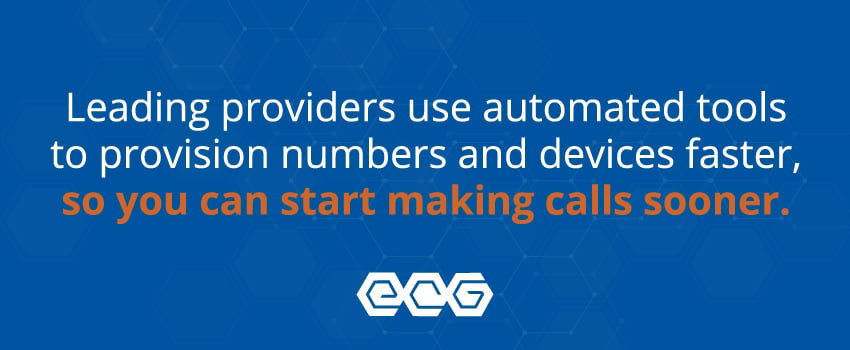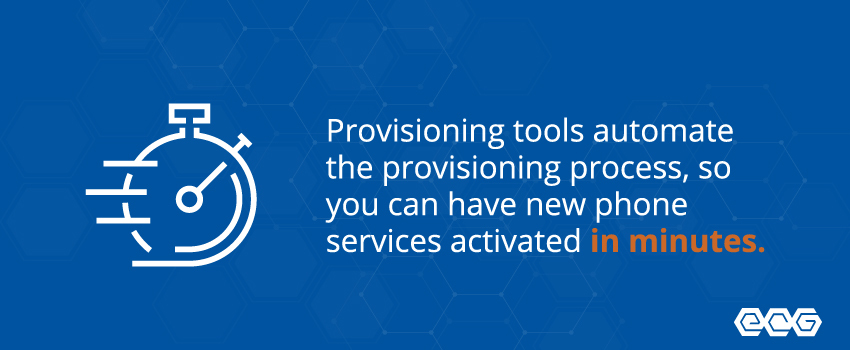Phone provisioning – the behind-the-scenes process of registering, activating, and configuring business phone numbers and devices – is crucial for seamless communications. While the phone provisioning process might sound technical, it's a fundamental aspect of modern telecommunications. Without it, your business phones won’t work.
When performed correctly, phone provisioning enables call routing, reliable voicemail, seamless transfers, and uninterrupted inbound and outbound calling via your business's phones. In this blog, we’ll explain everything you need to know about phone provisioning, including how it works, why it’s important, and how provisioning tools can help your business streamline the process.
How Are Phone Numbers Provisioned?
Most VoIP service providers allow you to browse available phone numbers and purchase the exact number or set of numbers you want for your business. Once acquired, they begin the provisioning process – registering, activating, and connecting the number to their voice network.
Once a phone number is provisioned, it's yours to start using. If your business switches service providers, you can port your phone number to the new provider. Your new provider provisions the ported number so that all call forwarding, routing, voicemail, and other functionality works on their network, ensuring you have minimal disruption to your phone services.
How Does Phone Provisioning Help Businesses?
The time it takes for your phone service provider to provision your numbers directly impacts your company's ability to communicate with customers. That's why you'll often find leading providers touting "fast provisioning" as a significant benefit of their services.
Fast, efficient phone provisioning allows you to set up critical features – such as call forwarding and routing rules – and start making calls to customers and partners. Phone provisioning also plays a role in keeping your phones up-to-date, applying new settings and policies, and resolving functionality issues with minimal disruption to your business operations.

Types of Phone Provisioning
There are three primary types of provisioning methods: manual, assisted, and automatic. Here’s how these methods differ:
Manual Provisioning
With manual provisioning, administrators configure individual devices one by one using either the phone's menus, web interface, or a combination of both. This method allows meticulous customization but is extremely time-consuming and difficult to scale.
Manual provisioning may make sense for smaller companies with a handful of devices or third-party phones not supported by automated tools. It also remains necessary for analog telephones, intercoms, overhead paging systems, and other specialty devices.
Assisted Provisioning
VoIP providers typically manage the provisioning processes when connecting new businesses to their services, so there isn’t a need for complete manual provisioning. Instead, the user will manually trigger automated provisioning on devices by entering details like the provisioning server address, which then pushes the necessary configurations on their behalf.
This method helps in situations where fully automatic provisioning may fail, like when phones need factory resets, when using phones purchased from unauthorized dealers, or when deploying phones to restrictive networks.
Automatic Provisioning
With automatic provisioning, devices fetch all necessary configurations from the provisioning server and complete the process without human intervention. This process enables simultaneous device administration from a central dashboard.
Automatic provisioning speeds up deployments of large phone fleets spanning hundreds of devices. It also helps ensure consistency in configuration across phone systems, making it essential for large organizations with complex communications needs.
Why Should Businesses Use a Provisioning Tool?
A provisioning tool is software that helps businesses simplify the phone provisioning workflow. It automates provisioning, enabling administrators to focus on performing tasks like monitoring phones, managing security, and upgrading firmware.
Provisioning tools are typically provided by phone manufacturers or service providers and often integrate with PBX software for easy configuration and number assignment. A good provisioning tool will include an intuitive interface for managing configurations and customizing phone settings so system administrators can roll out changes and updates to any number of devices in minutes.

Transform Phone Provisioning with ECG’s Alpaca
Proper phone provisioning is critical for ensuring your business phone system works seamlessly. Leveraging automated provisioning tools can help you streamline this vital process while eliminating time-consuming, error-prone manual efforts. However, not all provisioning tools are built the same, and finding the right one to meet your organization's needs can be challenging if you're not sure what to look for.
That’s where trusted voice network experts like ECG come in. ECG’s BroadWorks management toolset, Alpaca, was designed to help service providers simplify and streamline service activation. Our bulk provisioning feature automates the provisioning process, so you can set up new customers with the right numbers, devices, features, and more in minutes – rather than days.
Ready to transform your phone provisioning and service activation so you can solve customer problems immediately? Book a consult with ECG today.
